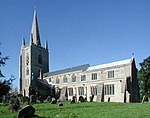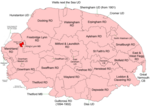St Mary the Virgin's Church, Wiggenhall
Church of England church buildings in NorfolkChurches preserved by the Churches Conservation TrustEnglish Gothic architecture in NorfolkEngvarB from September 2013G. E. Street buildings ... and 1 more
Grade I listed churches in Norfolk

St Mary the Virgin's Church is a redundant Anglican church in the civil parish of Wiggenhall St Germans, Norfolk, England. It is recorded in the National Heritage List for England as a designated Grade I listed building, and is under the care of the Churches Conservation Trust. The church stands at the end of a lane to the north of the village of Wiggenhall St Mary the Virgin, some 5 miles (8 km) south of King's Lynn. It is notable particularly for the quality of carving of its wooden fittings.
Excerpt from the Wikipedia article St Mary the Virgin's Church, Wiggenhall (License: CC BY-SA 3.0, Authors, Images).St Mary the Virgin's Church, Wiggenhall
Church Road, King's Lynn and West Norfolk Wiggenhall St. Germans
Geographical coordinates (GPS) Address Nearby Places Show on map
Geographical coordinates (GPS)
| Latitude | Longitude |
|---|---|
| N 52.7042 ° | E 0.3409 ° |
Address
Church Road
PE34 3EH King's Lynn and West Norfolk, Wiggenhall St. Germans
England, United Kingdom
Open on Google Maps








